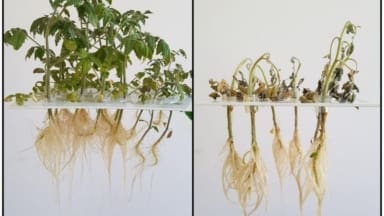
Bacterial wilt, also known as brown rot of potato, is caused by Ralstonia solanacearum which is a complex, genetically diverse strain of soil-borne bacteria, with a vast host range of more than 200 plant species. An economically significant disease, which can lead to serious crop losses of solanaceous vegetables, such as potato and tomato.
To date, we know that the bacterium settles in the water-bearing (xylem) channels of plant roots, blocking the upward flow of sap and eventually causing the plants to wilt. However, how Ralstonia manages to ‘deceive’ the plants’ immune system and thus infect the plant, isn’t known.
By means of his doctoral research, Joren De Ryck for the Flanders Research Institute for Agriculture, Fisheries and Food (ILVO) (and VIB and Ghent University) gained insight into the effect of pathogenic proteins that are injected into the plant by the bacteria. In concrete terms, De Ryck managed to map out where in the plant these proteins are active and was able to predict how they are constructed. He used a groundbreaking approach (the BioID method), in which plant proteins that are in the vicinity of the bacterial protein can be labeled and subsequently identified. De Ryck also developed an analytical technique that can be used in follow-up research to further unravel the molecular basis of the interaction between the tomato plant and the bacterium. “This information is desperately needed to understand the infection strategy of the pathogen and to eventually develop broad and sustainable resistance strategies”, explained De Ryck.
In the 1990’s, the ILVO Diagnostic Centre for Plants, discovered that Ralstonia had been introduced into the EU through the import of infected Egyptian early potatoes. The bacterium accidentally ended up in watercourses where Solanum dulcamara (Bittersweet nightshade) proved the ideal host plant for reproduction of the bacterium. The infected waterways then spread the brown rot, infecting the potato fields through their irrigation. A strict protection zone is currently in place across 45 Flemish municipalities, where the use of surface water for the cultivation of potatoes, tomatoes and aubergines is prohibited. All imported potatoes and seed potatoes are quarantined and systematically checked by the Plant Diagnostic Center, on behalf of the Federal Food Agency FASFC.
New ILVO research project to identify the exact source(s) of infection of the registered brown rot infections is to starting this year. In the project, DNA sequence techniques from forensic research will be used to analyse the genetic material of all the bacterial strains and search for links between brown rot infections and between brown rot infections in waterways. “This should give us more information about how the brown rot bacteria was introduced and spread. The ultimate goal is to find a way to identify the origin of infections more quickly in the future”, explains Johan Van Vaerenbergh, bacteriologist at the ILVO.

